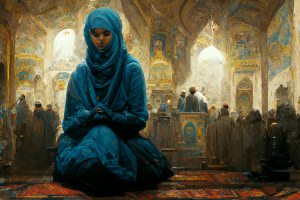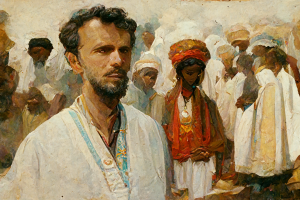Difference between revisions of "Incarnandism"
Trismegistus (talk | contribs) m |
Trismegistus (talk | contribs) m |
||
| Line 39: | Line 39: | ||
=Conversion to Incarnandism= | =Conversion to Incarnandism= | ||
| − | The early Incarnandists shared their message with other Khahonrites and visitors to their land, garnering a few converts. Before the missions of the [[Archapostle]]s in the 800's, there was not a strong effort to evangelize the message of Shaqtirah. | + | [[See also|Incarnandist Proselytizing]] |
| + | [[File:IncarnandistMissionary_A_MDJ.png|thumb|300px|An early Incarnandist visiting other lands to find converts to his religion. Midjourney 2022.]] | ||
| + | |||
| + | The early Incarnandists shared their message with other Khahonrites and visitors to their land, garnering a few converts. Before the missions of the [[Archapostle]]s in the 800's, there was not a strong effort to evangelize the message of Shaqtirah. | ||
=Gentile Incarnandism= | =Gentile Incarnandism= | ||
Revision as of 12:36, 21 August 2022
![]() The belief system of the Shenimite Tribe of Jerushabla, adopted by many people and psychics of the Pallathantic, Incarnandism is the belief that the collective intelligence of the universe will take upon itself a human form in the future to overcome the power of entropy. Incarnandists often repeat the words, "The universe will be made flesh," and believe that it is essential to understand and prepare for God's coming. The line of Incarnandinas will at some future date give birth to a male human who will fulfill this role.
The belief system of the Shenimite Tribe of Jerushabla, adopted by many people and psychics of the Pallathantic, Incarnandism is the belief that the collective intelligence of the universe will take upon itself a human form in the future to overcome the power of entropy. Incarnandists often repeat the words, "The universe will be made flesh," and believe that it is essential to understand and prepare for God's coming. The line of Incarnandinas will at some future date give birth to a male human who will fulfill this role.
Incarnandists claim that the holy scriptures of the Khahonri Prophets of Jerushabla predict and foreshadows the Incarnandus. The first teacher and revelator of the Incarnandus religion in our age, they believe, was Shaqtirah or Holy Shaqtirah, Mother of the Mothers of God.
The Incarnandist Religion today is generally respected in the West. Shenimite energists are honored as the descendants of the ancient tisbajutha who liberated the Pallathantic nations from powerful Chaos Rulers during the Isbajutha. However, the mission and aftermath of the Isbajutha is viewed with mixed and even negative perspectives by some people and institutions of the Pallathantic Region.
Origins
Many children of the Shenimite Tribe of Jerushabla were being born with the psychic gift—much more than was ever known among humans—though their numbers were still relatively small. An explanation was in order and the midwife, Saint Shaqtirah kath Katima revealed the gospel of the Incarnandus—that the Universe itself as manifested by God would transform himself and be born a human being. The Jerushablans largely rejected the words of the new prophetess, but most of the Shenimites accepted these revelations. Shaqtirah further revealed that God was causing the Shenimite women to give birth to more psychics to prepare the earth for the Incarnandus. She taught that mortals were to reject priesthoods as abominations and ready themselves to receive a higher priesthood when the Incarnandus arrived sometime in the future. She said that the priesthood of the Jerushablans had become corrupted and God no longer validated it. She taught her followers to spread the message of the gospel of Incarnandus, so that the world could prepare for the coming of God. Men could prepare by living a pure life and meditating on the Incarnandus daily. She chose seven followers to become Arch-Apostles of the Incarnandus to preach the word throughout the world, Thaulephus, Shannadh, Gerrick, Deelah, Rhamrhoth, Thyssa, and Brayand. Each Arch-Apostle in turn was to choose a successor Apostle and thus bring the total number up to fourteen which added to the number of St. Shaqtirah herself, produced the Sacred Number Fifteen.
The Anceps
The traditional symbol of the Incarnandist religion, the anceps was widely adopted sometime during the Middle Ages of Chaos. The symbol represents the duality of the universe and the Supreme Being, between the Infinite and the Finite, and also foreshadow God becoming human. It is also evocative of the esoteric teaching "As within, so without." The anceps can assume one of two positions. With the smaller half-circle turned to one side, it represents the anceps of contemplation, specifically contemplation of the Incarnandus. With the small circular pointed upwards (or atop the greater circle), it represents the militant anceps used by tisbajuma during their campaigns against the Chaos Rulers.
Core Beliefs
Khahonrite Origins
The first Incarnandists were members of the Shenimite Tribe of the Khahonrite people of Jerushabla. They were largely observant Yalists. Some of them were Proto-Incarnandist, that is, they believed that God Universal would somehow come into a mortal, human body.
The Incarnandus
The Incarnandus is the interpretation into general language of the name of the sacred manifestation of the universe. Incarnandists believe that the physical universe is fallen and cannot be placed on the path to restoration with the divine universe unless the divine universe manifests in the physical universe. This particular manifestation of the divine, what is often called God, is the Incarnandus -- he who must be born.
The Incarnandina
The present heir to Shaqtirah kath Katima is the Incarnandina. She is the woman foretold to give birth to the next Incarnandina. The succession is to continue until the Incarnandina Ultima or the final Incarnandina who according to Incarnandist prophecy will bear God in human form. The succeeding Incarnandina is the youngest surviving daughter of the Incarnandina.
The living Incarnandina holds immense power in the Incarnandist community. She is thought to have special protection from God and guidance from God about the whole world and particularly the leadership of the Incarnandist community.
Principle of Succession
By principles established fairly early in the newly revealed religion, the role of Incarnandina is transmitted to the youngest surviving daughter upon the death of the mother. The daughter's father is irrelevant. If the line is broken, then it reverts to the next youngest daughter and next youngest aunt as necessary.
Ecstatic Union with God
An important practice of Incarnandism is meditation which is thought to purify the soul and in time enable the possibility of ecstatic union with God in a meditative state of mind and spirit.
Conversion to Incarnandism
The early Incarnandists shared their message with other Khahonrites and visitors to their land, garnering a few converts. Before the missions of the Archapostles in the 800's, there was not a strong effort to evangelize the message of Shaqtirah.
Gentile Incarnandism
The number of non-Khahonrite Incarnandists grew greatly in the 800's and formed the body of Gentile Incarnandists, mainly in Ambrinqua, Ithatia, Corundy, and Pytharnia. The practice of Incarnandism among non-Khahonrite persons is sometimes called 'Vulgar' Incarnandism or 'Popular' Incarnandism. It vied with High Mandonism for disciples, especially in Ambrinqua and Corundy, and later in Pytharnia.
Ancient Arathracian Reaction
The ancient Yophenthean Arathracian rulers of the world took a dim view of the message of Shaqtirah, calling it the Sactirate Heresy. Most missionaries of the Incarnandist Religion were persecuted and martyred by the local magistrates, priests of the Arathracian Religion, or worshipers of the Old Religion.
Non-Incarnandist Reaction and Syncretism
Most inhabitants of the Pallathantic nations subscribe to some degree to the Old Religion. Incarnandists are seen as holy and devout, but exceptional and people do not feel a strong compulsion to forsake their ancestral gods in favor of the belief of the Incarnandus. Thus, while not skeptical, most consider the worship of the Incarnandus impractical and even irrelevant. Skeptics insist that since all the powers of the Incarnandist missionaries and saints stem from psychic ability, the belief itself is really not a true religion. Others, however, have adopted a middle-way, a syncretic adaptation where both the Incarnandus and the Isxinthion Gods are honored. Since some Incarnandists practice their devotions privately, the true numbers of all Incarnandists in a given nation are not certain.
Struggle with Arathracianism
In the 900's, the Arathracian Church strove with Gentile Incarnandism to be the successors to High Mandonism.
Common Incarnandism
Many typical people in the Pallathantic Nations and indeed other parts of the world mix the worship of their local gods with the teachings of the Incarnandus. This syncretism is very widespread, so that while "pure" Incarnandists are a true minority, as many as half of the people of a given nation may practice some forms of Incarnandism.
Incarnandist Scripture
Incarnandists accept many of the beliefs the Khahonri and some of their religious books. They also accept the religious writings of the Incarnandist Saints, although some works are more openly accepted than others. The Incarnandina has made some statements about some books and consequently they are considered canon, but has not openly rejected others. The current compilation of the Incarnature was largely the work of Sage Basmeath under the diretion of the Incarnandina.
Incarnandist Costume
Incarnandists typically follow the costume of the culture in which they live. On holy days, Incarnandists often don robes of linen of black, brown, or tan, but preferring grey and white. New-born children of Incarnandists are swaddled in fine white linen, then dedicated to the Incarnandus. Incarnandists who have made monastic or militant vows wear these types of clothes all the time.
Incarnandist Saints
The first Saint of the Incarnandist Religion is Shaqtirah kath Katima, but Incarnandists are quick to point out that only God who is to come in human form is truly holy. Shaqtirah chose seven Arch-Apostles and these men and women have been recognized as Saints of Incarnandism since very early on in the religion. Incarnandists do not pray to their saints but acknowledge the holiness of their lives and their place in God's heaven.
Tension with other religions
Yalism (Khahonrite Ethnic Religion)
Arathracian Religion
Traditional Isxinthion Religion
Reaction among Humanlikes
Incarnandist Populations
Devout Incarnandists are commonly a minority among human populations, with the exceptions of Oliblish, Amerzcelindo, and to some extent, Umbardia, where they are the majority. Incarnandists are rarer east of the Jaggudorns and outside the sphere of influence of the Pallathantic Nations.
Incarnandists are most frequent in cities and towns of the world. In the rurals and wilderness, they ban together in small communities centered on monastic sanctuaries. In this regard Incarnandists are paradoxical, perhaps, as they cluster in highly populous cities and towns, but have a significant, if isolated, presence in the wilderness and the rural places of the world.
Highest Percentage of Incarnandists among their Human Population, In order from Most to Least
See also Religious Populations of Asdar.
Occurrence of Incarnandists among Humanlike Races
Incarnandism occurs much less commonly among the non-human races of the world. Of these, it is most likely (although a minority) among half-orcs and halflings. There is a significant minority of Incarnandists among orcs and dwarves. For example, many of the energist warriors of dwarven Gdelisica are Incarnandist.
Incarnandist Theology
Nobody speaks directly for God. Only one's heart can speak best for God. On fast days, the images of Incarnandist Saints are covered because you should be contemplating God and your own connection to God.
Local Incarnandists choose their saints. Incarnandism teaches self-control, rather than a top-heavy central authority. Meditation and contemplation are the most important pursuits. Helping others to come to God is the next most important.
God is infinite and manifests in infinite form.
The human soul undergoes numerous reincarnations in order to grow before it can advance to a higher state.
Pacifism vs. Militancy
The subtle rift that has occasion to swell to disagreement among incarnandists arises from the philosophical divide between the faithful who adhere to a belief in minimal violence at all costs and the militant faithful who have embraced war as a means to liberate the captives as an expression of God's power and mercy. The divide was strongest during the time of the Isbajutha. Today, the place of Incarnandists is much more secure in the Pallathantic and the need to organize for war is rare. Consequently, the philosophical rift has receded, but can rise under the right conditions. Pacifists insist that peaceful meditation and avoidance of conflict are at the origins of Incarnandism. The militants, however, contend that only by opposing and defeating the Chaos Lords was the world transformed and prepared for the coming of the Incarnandus. The pacifists believe that the limiting nature of duality inherent to conflict prevents the worshiper from transcending the illusion of the physical realm and returning to deity.
Sects
Other Religions deriving from Incarnandism or incorporating Incarnandism
- Archontism
- Barathornish Incarnandism, see also Saint Gryvant the Blue, Missionary Work in Barathorn, ca. 1370; greatly influenced Incarnandism in Orrhymby. "I live in the expectation of the Son of the Universe."
- Hamagnosticism
- Omasoni
- Paimbalans
- Sulism
- S'ubhalites (S'ubhal of Syre)
Traditions
Incarnandists observe certain traditions that are important to their practice but not essential or core to their theology. Shenimite Incarnandists continue to observe certain cultural practices from before the time of Shaqtirah kath Katima when they worshiped the god Yal. The Khahonri anciently did not eat pork because they believed that the giants and other evil, magic-using beings could change humans into pigs. So to avoid eating a human being, you had to simply avoid eating pigs altogether. The Incarnandist Shenimites avoided eating pork because they believe some gods of chaos can gain control over your body if you eat it. Non-Shenimite Incarnandists generally eat pork as they do not believe that chaos gods are any more likely to use pigs than any other creature to work their nefarious ends.
See Also
- Incarnandist General Congregation
- Hamagnosticism
- History of Incarnandism
- Incarnandina
- Incarnandist Practice and Worship
- Incarnandus
- Interpretatio Incarnandista
- List of Incarnandinas
- List of Incarnandist Saints
- List of Incarnandist Sects
- Religions
- Religious Populations of Asdar
- Seven Archapostles of Incarnandism
- Yalism
| This article is a stub. It requires further development by the creator. |


